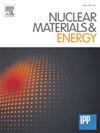Studies of material deposition during boronization using quartz crystal microbalance in EAST
IF 2.7
2区 物理与天体物理
Q1 NUCLEAR SCIENCE & TECHNOLOGY
引用次数: 0
Abstract
Boronization is a widely employed technique for controlling fuel recycling and suppressing impurities. It is expected to be a routine wall conditioning method in the fully tungsten (W) wall configuration of the International Thermonuclear Experimental Reactor (ITER). To evaluate boron (B) performance under ITER-relevant metal wall conditions, ion cyclotron range of frequency (ICRF)-assisted boronizations were conducted in the Experimental Advanced Superconducting Tokamak (EAST) from 2023 to 2024. Quartz crystal microbalances (QMBs) installed at the mid-plane of ports C (C-QMB) and J (J-QMB), positioned well beyond the limiter, were utilized for in-situ and real-time measurements of material deposition rates during boronization using sublimation of carborane. Deposition rates ranged from 0.31 to 3.40 μg cm-2h−1 at C-QMB and 0.04 to 16.95 μg cm-2h−1 at J-QMB, exhibiting more spatially uniform profiles than lithium (Li) coatings. Deposition behavior was systematically studied and found to depend on the locations of the carborane sublimation oven and ICRF antenna, the temperatures of both the oven and substrate, and the substrate material. Higher deposition rates were associated with elevated plasma parameters in closer proximity to the ICRF antenna, denser gaseous carborane near the oven, and increased oven temperature. In contrast, deposition was reduced on high-Z substrate (W) and at elevated first wall temperature (70 °C). These findings provide further information for the optimization of boronization strategies in future fusion devices.
用石英晶体微天平在EAST中研究硼化过程中的物质沉积
硼化是一种广泛应用于控制燃料循环和抑制杂质的技术。它有望成为国际热核实验反应堆(ITER)全钨(W)壁配置的常规壁调节方法。为了评估硼(B)在iter相关金属壁条件下的性能,于2023年至2024年在实验先进超导托卡马克(EAST)上进行了离子回旋加速器频率范围(ICRF)辅助硼化。石英晶体微天平(qmb)安装在C (C- qmb)和J (J- qmb)端口的中间平面,远远超出限制,用于原位和实时测量碳硼烷升华硼化过程中的材料沉积速率。C-QMB的沉积速率为0.31 ~ 3.40 μ cm-2h−1,J-QMB的沉积速率为0.04 ~ 16.95 μ cm-2h−1,表现出比锂离子涂层更均匀的空间分布。系统地研究了沉积行为,发现沉积行为取决于碳硼烷升华炉和ICRF天线的位置、炉和衬底的温度以及衬底材料。较高的沉积速率与靠近ICRF天线的等离子体参数升高、靠近烘箱的气体碳硼烷密度增加以及烘箱温度升高有关。相比之下,在高z基板(W)和提高第一壁温度(70°C)时,沉积减少。这些发现为未来核聚变装置中硼化策略的优化提供了进一步的信息。
本文章由计算机程序翻译,如有差异,请以英文原文为准。
求助全文
约1分钟内获得全文
求助全文
来源期刊

Nuclear Materials and Energy
Materials Science-Materials Science (miscellaneous)
CiteScore
3.70
自引率
15.40%
发文量
175
审稿时长
20 weeks
期刊介绍:
The open-access journal Nuclear Materials and Energy is devoted to the growing field of research for material application in the production of nuclear energy. Nuclear Materials and Energy publishes original research articles of up to 6 pages in length.
 求助内容:
求助内容: 应助结果提醒方式:
应助结果提醒方式:


